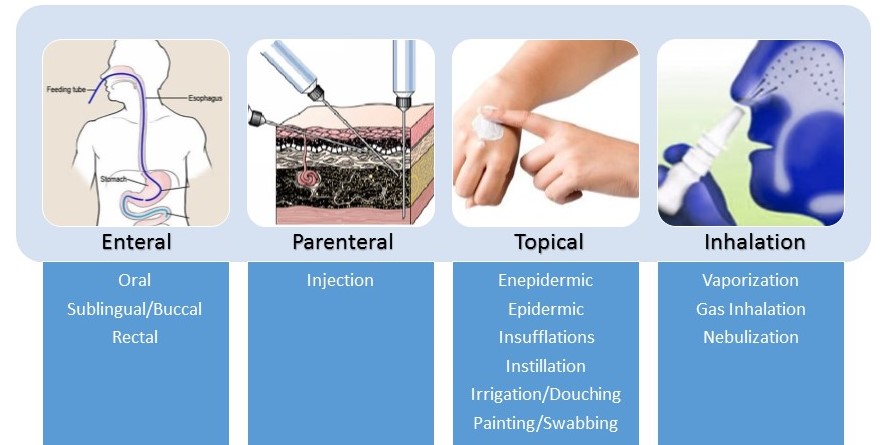Techniques of Medication Administration
Published .

Enteral (digestive track) Routes of Medication Administration
- Oral administration of medication is a convenient, cost-effective, and most commonly used medication administration route. The primary site of drug absorption is usually the small intestine, and the bioavailability of the medication is influenced by the amount of drug absorbed across the intestinal epithelium. The first-pass effect is an important consideration for orally administered medications. It refers to the drug metabolism whereby the drug concentration is significantly diminished before it reaches the systemic circulation, often due to the metabolism at the liver.
- A sublingual or buccal route is another form of the enteral route of medication administration that offers the benefit of bypassing the first-pass effect. By applying the drug directly under the tongue (sublingual) or on the cheek (buccal), the medication undergoes a passive diffusion through the venous blood in the oral cavity, which bypasses the hepatic portal vein and flows into the superior vena cava. Compared to sublingual tissue, which has a highly permeable mucosa with rapid access to the underlying capillaries, buccal tissue is less permeable and has a slower drug absorption.
- A rectal route is another enteral route of medication administration, and it allows for rapid and effective absorption of medications via the highly vascularized rectal mucosa. Similar to sublingual and buccal routes, rectally administered medications undergo passive diffusion and partially bypass the first-pass metabolism. Only about half of the drug absorbed in the rectum directly goes to the liver.
Parenteral (outside the digestive tract) Route of Medication
- Intravenous injection is the most common parental route of medication administration and has the benefit of bypassing the first-pass metabolism by the liver. Given their superficial location on the skin, peripheral veins provide easy access to the circulatory system and are often utilized in the parenteral administration of medications. The upper extremity is usually the preferred site for intravenous medication as it has a lower incidence of thrombophlebitis and thrombosis than the lower limbs. The median basilic or cephalic veins of the arm or the metacarpal veins on the hand’s dorsum are commonly used. In the lower extremity, the dorsal venous plexus of the foot can be used.
- An intramuscular medication route can be administered in different body muscles, including deltoid and vastus lateralis muscles.
- Subcutaneous injections are another form of the parental route of medication and are administered to the layer of skin referred to as cutis, just below the dermis and epidermis layers. Subcutaneous tissue has few blood vessels; therefore, the medications injected undergo absorption at a slow, sustained rate. Subcutaneous medication can be administered to various sites, including the upper arm’s outer area, abdomen avoiding a 2-inch circle around the navel, the front of the thigh, upper back, or the upper area of the buttock behind the hip bone.
Other Routes of Medication
- An intranasal drug route facilitates drug absorption by passive diffusion across the single-layered, well-vascularized respiratory epithelium directly into the systemic circulation.
- An inhaled medication is delivered rapidly across the large surface area of the respiratory tract epithelium. Drugs absorbed into the pulmonary circulation enter directly into the systemic
Reassessment
After administering a medication, regardless of route, the medics must document the administration any changes in the patient’s condition on a patient care report. Documenting a change (hopefully for the better) in a patient’s condition after a medication has been delivered will aid in ensuring the patient is diagnosed properly and that the medication’s maximum dose has not been exceeded.
